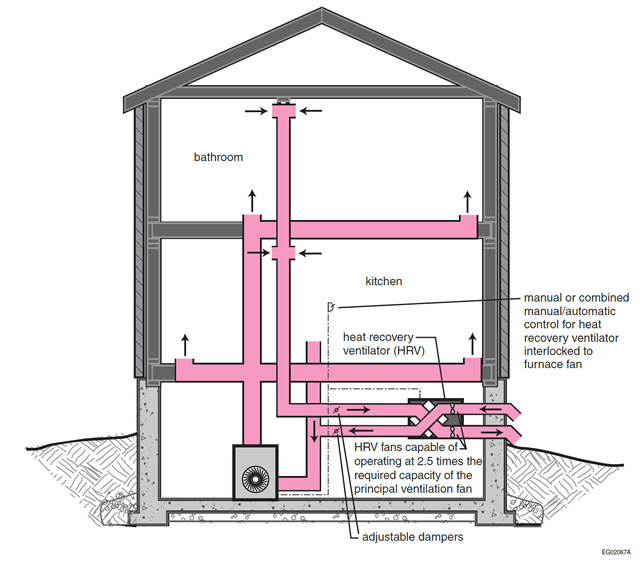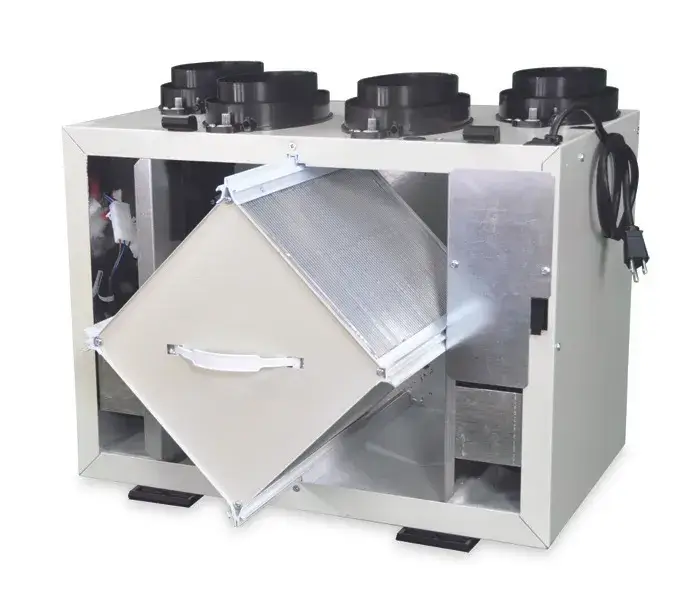Ways to Improve Your Indoor Air Quality and Energy Efficiency – HRV or ERV

If you want to improve the indoor air quality and energy efficiency of your home or business, you might want to consider installing a mechanical ventilation system. The most optimal ventilation strategy today is with a ‘balanced’ ventilation system. It is superior to exhaust-only or supply-only strategies because it does not affect the pressure of a building. Some building codes and authorities require that the ventilation be balanced due to the strict airtightness standards of building exteriors. The negative or positive pressure in your building can also create drafts, moisture problems and operational issues with certain combustion appliances.
As such, two main types of ventilation systems can provide continuous and predictable air exchange, while recovering some of the heat or energy in the process: HRV (heat recovery ventilator) and ERV (energy recovery ventilator).
What is the difference between HRV and ERV?
The main difference between these two systems is that HRV recovers only heat from the outgoing air, while ERV recovers both heat and moisture. This means that HRV can help reduce heating costs and prevent moisture problems in your home, while ERV can help maintain a comfortable humidity level and reduce cooling costs. The choice between HRV and ERV depends on your local climate, your heating system, your ventilation needs and your budget.
How does an HRV work?
An HRV is a system that uses the heat in stale exhaust air to preheat incoming fresh air. This reduces the energy required to bring outside air up to ambient room temperature, so you save money on heating bills. An HRV also helps prevent condensation and moisture problems in your home by exhausting humid air from bathrooms, kitchens, and laundry rooms.
A typical HRV consists of two fans: one that draws in fresh air and one that expels stale air; and a heat exchanger that transfers heat between the two air streams. The heat exchanger is usually made of metal or plastic plates that are separated by a small gap. The two air streams pass through the plates without mixing, but exchange heat through convection: similar to a car radiator.

Source: NRC 2019
How does an ERV work?
An ERV has the same components as an HRV, but the heat exchanger is different. Instead of metal or plastic plates, an ERV uses a synthetic membrane or a desiccant wheel that allows moisture and energy to pass through, but not air. The membrane or wheel rotates between the two air streams, absorbing moisture and energy from one side and releasing it to the other. This means that an ERV can help maintain a comfortable humidity level in your home, as well as reduce the cooling load in summer. An ERV can also filter out some of the pollutants and allergens from the outdoor air, such as dust, pollen, and smog.
How to save costs with an HRV or an ERV?
Whether you choose an HRV or an ERV, there are some ways to save cost and energy in designing, installing, and operating your ventilation system:
- Choose a system that is ENERGY STAR® certified. This means that the system meets high standards of performance and efficiency. You can also check the ratings of different systems on HVI, which is an independent organization that tests and certifies ventilation products.
- Choose a system that matches the size and layout of your home. A system that is too small or too large will not provide adequate ventilation or will waste energy. You can consult a professional contractor or an engineer to help you determine the optimal size and design of your system.
- Choose a system that has variable speed fans and controls. This allows you to adjust the ventilation rate according to your needs and preferences. You can also use timers, sensors, or smart thermostats to automate the operation of your system and optimize its efficiency.
- Choose a system that has good filters and seals. This ensures that the system does not leak air or lose heat or energy. You should also clean and replace the filters regularly, according to the manufacturer’s instructions.
- Choose a system that has a defrost cycle. This prevents the heat exchanger from freezing in cold weather, which can damage the system or reduce its efficiency. The defrost cycle should be automatic and energy efficient.
Latest Products and Technologies
The technology of HRV and ERV is constantly evolving, and there are new products and techniques that can enhance the performance and functionality of your ventilation system:
- Some systems have integrated heating or cooling coils that can further modify the temperature of the incoming air, depending on your needs. For example, you can use a heat pump to boost the heating or cooling capacity of your ERV.
- Integrated Filtration Systems: Many HRV and ERV systems now come equipped with advanced filtration systems that can capture a wide range of airborne contaminants, including dust, pollen, allergens, and pathogens. Some models even feature HEPA filters or UV-C sterilization to provide cleaner and healthier indoor air.
- Compact and Space-Saving Designs: Manufacturers have been developing more compact and space-saving HRV and ERV systems to accommodate installation in smaller or tighter spaces, such as condos, apartments, and tiny homes. These streamlined designs make it easier to incorporate ventilation systems into a variety of residential and commercial settings.

Conclusion
HRV and ERV are both effective ways to ventilate your home while recovering some of the heat or energy from the outgoing air. The main difference between them is that HRV recovers only heat, while ERV recovers both heat and moisture. The choice between them depends on your local climate, your heating system, your ventilation needs and your budget. You can also save cost and energy by choosing a high-quality system that is properly sized, designed, installed and operated. You can also benefit from some of the latest products and techniques that can enhance the performance and functionality of your ventilation system.
